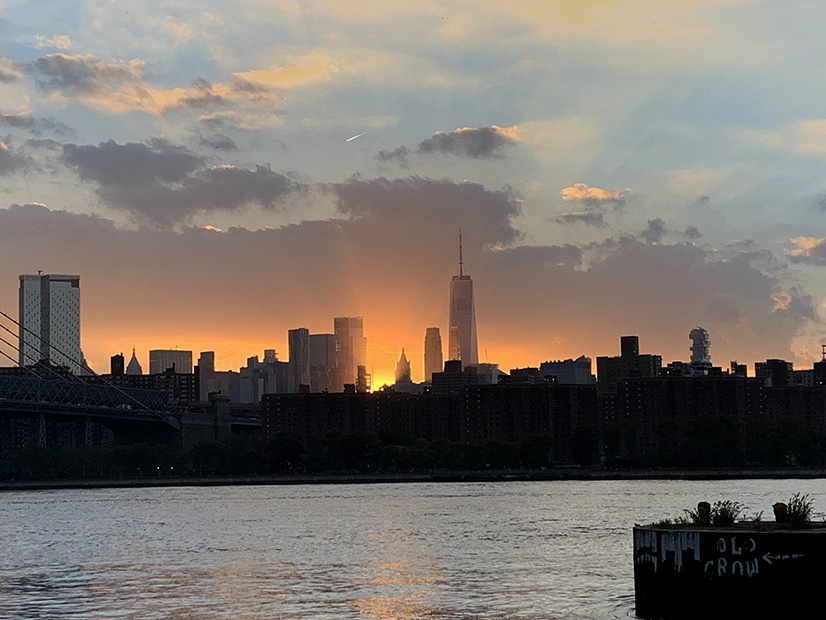
The owners of a commercial high-rise in Lower Manhattan are targeting lost heat as part of a decarbonization pilot for the Empire Building Challenge in New York.
“345 Hudson [St.] is the quintessential New York City building at 17 stories, with almost a million square feet, and built in the 1930s,” Michael Izzo, vice president of carbon strategy for the real estate firm Hines, said Thursday.
The building has 54% energy waste, which represents a significant portion of the $3 million the owners spend on energy each year, Izzo said during an Empire Building Challenge event hosted by Building Energy Exchange and the New York State Energy Research and Development Authority (NYSERDA). Hines is the operating partner for Hudson Square Properties, a portfolio of 12 buildings that includes 345 Hudson.
As one of four high-rise retrofits selected in January for the building challenge, the pilot at 345 Hudson is all about decarbonizing heat through recycling, according to Izzo.
“When we talk about heating, our steam system was designed in the early 1900s, and our fossil-fuel systems and boilers in the 1950s,” he said. “That infrastructure has not changed.”
For the pilot, the owners will turn to air-to-air energy recovery and heat-pump technology to recycle energy. Some wasted energy from the building will transition to an adjacent building or go to thermal storage before any excess is vented outside.
New York City has more than 1 million buildings that are responsible for 70% of the city’s carbon emissions, according to Richard Yancey, executive director of Building Energy Exchange. Most of the city’s buildings, he said, were built before the advent of current codes and standards and “fall far short of their performance potential.”
The 2019 Climate Mobilization Act set emission standards for the city’s buildings that go into effect in 2024 and increase every five years. Those standards, together with a recent ban on fossil-fuel-burning equipment in new construction and renovations in the city, have “ignited a retrofit revolution at an unprecedented scale,” Yancey said.
By 2050, he added, 90% of the city’s buildings will need to complete energy efficiency upgrades.
“The retrofit market will be colossal,” reaching between $17 billion and $24 billion within 10 years, he said.
Launched in September 2020, the Empire Building Challenge now has 10 real-estate portfolio owners, representing 700 buildings, working on high-rise, low-carbon demonstrations.
Gov. Kathy Hochul awarded Hines, Empire State Realty Trust, L+M Development Partners and Omni New York $5 million each through a competitive solicitation for their replicable high-rise retrofit projects that address barriers to decarbonization.
“We’ve been working closely with these partners for well over a year,” said Janet Joseph, senior vice president of strategy and market development at NYSERDA. “We’re very excited to move to this next phase of implementation and, hopefully very soon, construction.”
Other Projects
The Empire State Realty Trust plans to make the Empire State Building carbon neutral by 2030, according to Dana Schneider, senior vice president and director of energy and sustainability.
Initial carbon reduction measures, such as moving from steam to electric chillers, have reduced emissions 54% in the iconic building, and the goal is 80%, she said.
Through the building challenge, the trust is upgrading the Empire State Building’s control systems to improve system performance.
“We’re doing a lot of work to control our steam,” which Schneider said will be critical while the trust tries to make a business case for replacing steam systems with electricity. “Sometimes that’s difficult to do, and it’s certainly difficult to do all at once.”
At The Heritage in Harlem, L&M will update the 600-unit apartment complex with an insulated façade and a thermal heat-pump system in one of the buildings.
The three-building complex was constructed in the 1970s as a prototype for affordable housing that integrated a federal Head Start program and a center for child development, according to Joseph Weishaar, vice president of L&M fund management.
Working with the building challenge will allow L&M to electrify domestic hot water on the property.
“There are new domestic hot water plants that can compete with natural gas on an operating cost basis, but their upfront cost is very high,” Weishaar said.
L&M will connect heat pumps to a centralized control system so that the building can respond to grid conditions.
Whitney Young Manor, a 12-story, 1970s apartment complex in Yonkers, will receive an insulated exterior façade upgrade as part of Omni’s pilot.
The building is on a path to carbon neutrality by 2035, said Anna Weiss, vice president of Omni.
One of the major retrofit challenges for the project, she said, is installing and maintaining technology that is not “fully vetted” for cold weather.
In addition to upgrading the building envelope, Omni will install an air-source heat pump heating and cooling system with a central loop. Domestic hot water will transition to a water heat pump system that feeds off the air-source central loop. Backup gas boilers will be available on the building’s roof in the event of extreme cold weather.
“If we have an emergent situation in a blackout, we can be assured that our tenants will still have heat and they will be comfortable in our apartments,” she said.
